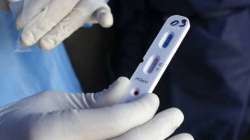Combination of self-isolation, testing, contact tracing needed for containing pandemic: Lancet study
In the absence of a vaccine or highly effective treatments for COVID-19, scientists believe that a combination of measures such as intensive testing, and contact tracing along with physical distancing and remote working are needed to contain the pandemic.

In the absence of a vaccine or highly effective treatments for COVID-19, scientists believe that a combination of measures such as intensive testing, and contact tracing along with physical distancing and remote working are needed to contain the pandemic. According to a new modelling research, published in the journal The Lancet Infectious Diseases, combining intensive contact tracing along with physical distancing measures may be the most efficient way to control the spread of the novel coronavirus, SARS-CoV-2.
It noted that a high incidence of COVID-19 would require a considerable number of individuals to be quarantined to control infection.
Citing an example, the researchers, including those from the University of Cambridge in the UK, said if about 5,000 new symptomatic cases were diagnosed each day, it may require 1,50,000-2,00,000 contacts to be quarantined every day if no physical distancing was in place.
They said the study is the first to use social contact data to quantify the potential impact of control measures on reducing individual-level transmission of SARS-CoV-2 in specific settings.
In the study, researchers analysed data on how 40,162 people moved about the UK and interacted with others prior to COVID-19.
Based on this, they simulated how combinations of different testing, isolation, tracing, and physical distancing scenarios-such as app-based tracing, remote working, limits on different sized gatherings, and mass population-based testing-might contribute to reducing secondary cases.
They aimed to identify not only what would theoretically control transmission, but also what the practical implications of these measures would be.
However, they said the model is based on a series of assumptions about the effectiveness of testing, tracing, isolation, and quarantine.
They assumed that the amount of time it takes to isolate cases with symptoms was on average 2.6 days, and the likelihood that their contacts adhere to quarantine was 90 per cent.
According to the scientists, while these considerations are plausible, they are optimistic assumptions.
"Our findings reinforce the growing body of evidence which suggests that we can't rely on one single public health measure to achieve epidemic control", said Adam Kucharski, study co-author from the London School of Hygiene & Tropical Medicine in the UK.
"Successful strategies will likely include intensive testing and contact tracing supplemented with moderate forms of physical distancing, such as limiting the size of social gatherings and remote working, which can both reduce transmission and the number of contacts that need to be traced," Kucharski said.
The huge scale of testing and contact tracing needed to reduce COVID-19 from spreading is resource intensive, the researchers said, adding that app-based tracing, if adopted widely alongside traditional contact tracing, could enhance the effectiveness of identifying contacts.
In the research, the scientists also modelled the rate at which the virus is transmitted -- known as the reproductive number (R), or the average number of people each individual with the virus is likely to infect at a given moment -- under different strategies.
They said, to keep the COVID-19 pandemic declining, R value needed to be less than one.
In the model, the researchers assumed the the probability that a close contact of a confirmed case will be infected to be 20 per cent among household contacts and 6 per cent among other contacts.
They estimated that if no control measures had been implemented, R would be 2.6, meaning that one infected person would infect, on average, 2-3 more people.
According to the model, mass testing alone, with 5 per cent of the population undergoing random testing each week can lower R to just 2.5, because so many infections would either be missed or detected too late.
Compared with no control measures, self-isolation of symptomatic cases alone reduced transmission by an estimated 29 per cent, while combining self-isolation, household quarantine, and tracing strategies may lower transmission by as much as 47 per cent when using app-based contact tracing.
Limiting daily contacts outside home, school, and work to four people along with manual tracing of acquaintances only, and app-based tracing, would have the greatest impact, reducing disease spread by 66 per cent, and lowering R to 0.
87, the study noted.
However, the scientists said the effectiveness of manual contact tracing strategies is highly dependent on how many contacts are successfully traced, with a high level of tracing required to ensure R is lower than one.
They also modelled the number of contacts that needed to be quarantined under different contact tracing strategies.
A scenario in which 1,000 new symptomatic cases were reported daily would likely require a minimum of 15,000 contacts quarantined every day and a maximum of 41,000 people, the researchers added.
"Our results highlight several characteristics of SARS-CoV-2 which make effective isolation and contact tracing challenging," said study co-author Hannah Fry from the University College London in the UK.
"The high rate of transmission, the short time between one person becoming infected and infecting another, and transmission that occurs without symptoms all make things difficult," Fry said.
For high numbers of symptomatic COVID-19 cases, tracing, testing, quarantining efforts will be a big challenge, the scientists said.
"If combined with moderate physical distancing measures, self-isolation and contact tracing would be more likely to achieve control of COVID-19," the scientists concluded.